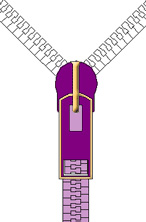 Whitcomb
L. Judson invented the zipper and YKK is the Japanese company that
makes them. Whitcomb
L. Judson invented the zipper and YKK is the Japanese company that
makes them.
Whitcomb L. Judson was a lover of gadgets
and machines and the idea for his "clasp locker" came
from when a friend had a stiff back from trying to fasten his shoes.
Judson's clasp locker was used mostly on mailbags, tobacco
pouches and shoes. However, his design, like most first inventions
needed to be fine-tuned.
A more practical version came on the scene in 1913 when a Swedish-born
engineer, Gideon Sundback revised Judson's idea and made his with
metal teeth instead of a hook and eye
design. In 1917, Sundback patented his "separable fastener."
The name changed again when the B. F. Goodrich Co. used it in rubber
boots, galoshes, and called it the
"zipper" because the boots could be fastened with one
hand.
The 1940s brought about research in Europe of the coil zipper design.
The first design was of interlocking brass coils. However, since
they could be permanently bent out of shape, making the zipper stop
functioning, it was rather bad for business and wasn't too practical.
The new design was improved after the discovery of stronger, more
flexible synthetics. Coil zippers
eventually hit the market in the early 1960s.
In 1934, Yoshida Kogyo Kabushililaisha was founded. Sixty years
later they changed their name to YKK Co. The privately owned firm,
headquartered in Japan, now is made up of 80 companies at 206 facilities
in 52 countries. Of course, the demand for zippers is great. YKK
makes everything from the dyed fabric around the zipper to the brass
used to make the actual device.
|
|
note:
|
gadget: 小玩意
tabacco pouch: 烟袋
fine-tuned: 调整
hook and eye: (起钮扣作用的)钩和孔
galosh: 橡胶套鞋
synthetics: 人造合成材料
|
|
